Authors: 0xjacobzhao and ChatGPT 5
In the report '(DeFi's Intelligent Evolution: The Pathway from Automation to AgentFi)', we systematically sorted and compared the three stages of DeFi's intelligent development: automation tools (Automation), intent-driven assistants (Intent-Centric Copilot), and AgentFi (on-chain agents). We pointed out that a significant portion of current DeFAI projects still focus on 'intent-driven + single atomic interaction' Swap trading, which does not involve continuous profit strategies, lacks state management, and does not require complex execution frameworks, making it more suitable for the lightweight execution mode of intent assistants and cannot be strictly regarded as AgentFi.
In our high-level vision for the future of AgentFi, apart from lending and liquidity mining—two of the most valuable and easily implementable scenarios—Swap combination strategies are also a potential direction. When multiple Swaps are combined sequentially or conditionally, they form a 'strategy chain', such as arbitrage or yield farming. This model requires state machine management of positions, condition triggers, and multi-step automation, embodying the complete closed-loop characteristics of AgentFi—perception → decision → execution → rebalancing.

1. DeFi Quantitative Strategy Map and Feasibility Analysis
Traditional quantitative finance relies on mathematical models, statistical methods, and algorithms, utilizing historical price, trading volume, macro indicators, and other data for data-driven decision-making, and executing programmatically for low-latency, high-frequency, automated trading, supplemented by strict risk controls (stop-loss, position management, VaR, etc.). Its main applications include high-frequency trading (HFT), trend following and mean reversion (CTA), cross-market/cross-commodity arbitrage, and derivatives pricing and hedging, having formed mature infrastructure, exchange systems, and data ecosystems in traditional markets.
On-chain quantitative finance continues the logic of traditional quant, but the operating environment has shifted to the programmable market structure of blockchain. Its data comes from on-chain transaction records, DEX quotes, and DeFi protocol states, executed in smart contracts (AMMs, lending, derivatives protocols), with trading costs including Gas, slippage, and MEV risks, and can build automated strategy links through the composability of DeFi protocols.
Currently, on-chain quantitative finance is still in its early stages, constrained by multiple factors that hinder the implementation of complex quantitative strategies: first, in terms of market structure, insufficient liquidity depth and AMM lacking ultra-fast matching mechanisms limit the feasibility of high-frequency and large transactions; second, in terms of execution and costs, on-chain block delays and high Gas fees make frequent trading difficult to profit; third, in terms of data and tools, the development and backtesting environments are inadequate, and the data dimensions are singular, lacking multi-source information such as corporate finance and macroeconomics. Among the practically implementable DeFi quantitative strategies, the current mainstream direction focuses on:
Mean Reversion / Trend Following - Making buy/sell decisions based on technical indicator signals (such as RSI, moving averages, Bollinger Bands);
Inter-period Arbitrage - Profiting from fixed and floating yield differentials, represented by protocols like Pendle;
Market Making + Dynamic Rebalancing - Actively managing AMM liquidity ranges to earn fees;
Leveraged cyclical yields - Enhancing capital utilization through lending protocols.
Potential growth areas in the future include:
Maturation of the on-chain derivatives market, particularly the widespread application of options and perpetual contracts;
More efficient off-chain data access, enriching model input dimensions through decentralized oracles;
Multi-Agent collaboration, achieving automated execution and risk balancing of multi-strategy combinations.
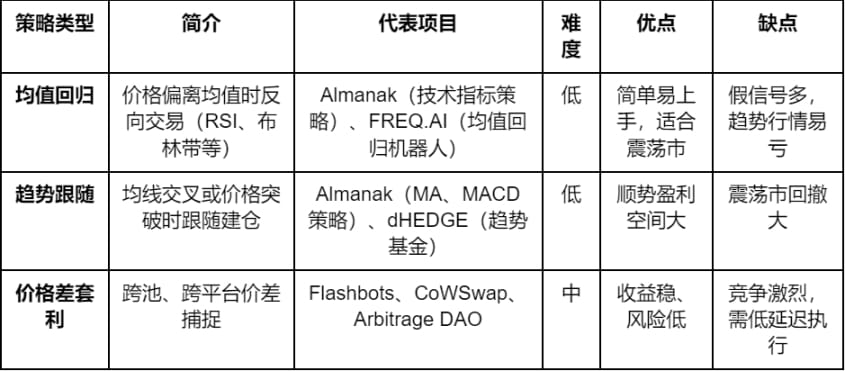
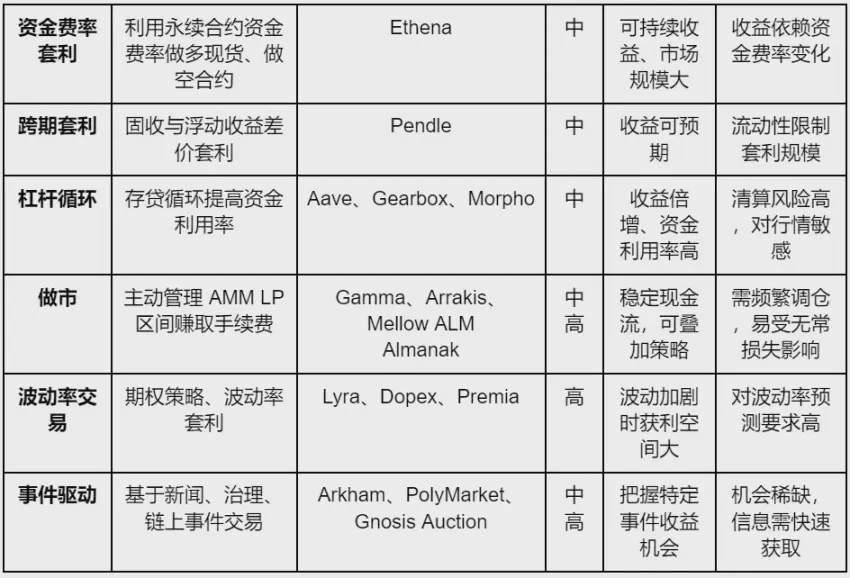
Two, Almanak's Positioning and Vision: Exploration of On-chain Quantitative Finance's AgentFi
In previous Crypto AI reports, we introduced many excellent AgentFi projects, but most still focus on intent-driven DeFi execution, lending, or liquidity management for fully automated operations, with few teams deeply engaged in quantitative trading strategies. Currently, there are almost no projects explicitly centered on quantitative trading in the market besides Almanak. This project cuts into no-code quantitative strategy development, providing a complete toolchain covering strategy writing (Python), deployment, execution, permission management, and vaulting (Vault), uniquely positioning itself in the AgentFi field as a core representative case of on-chain quantitative finance.
In traditional finance, Inclusive Finance aims to lower participation thresholds and cover more long-tail users. Almanak extends this concept to on-chain, aiming to democratize quantitative trading capabilities. The platform significantly reduces capital, technical, and time costs by executing strategies driven by AI agents, providing full-link support from strategy conception to on-chain execution for active traders, financial developers, and institutional investors within the DeFi ecosystem, allowing ordinary users to participate in crypto asset trading and yield optimization with fully automated, transparently on-chain, and customizable quantitative strategies, without needing a professional technical background.
The Almanak platform introduces AI multi-agent collaboration (Agentic Swarm), allowing users to quickly create, test, and deploy Python-based automated financial strategies in a no-code environment during strategy development, execution, and optimization, while ensuring the execution environment is non-custodial, verifiable, and scalable. With modules such as State Machine strategy framework, Safe+Zodiac permission management, multi-chain protocol access, and Vault asset custody, Almanak retains institutional-level security and scalability while significantly lowering the barriers to strategy development and deployment. This report will systematically analyze its product architecture, technical characteristics, incentive mechanisms, competitive positioning, and future development path, and explore its potential value in inclusive finance and on-chain quantification.
Three, Almanak's Product Architecture and Technical Characteristics
Almanak's product architecture is centered around 'strategy logic → execution engine → security assurance → assetization and expansion', building a full-stack on-chain quantitative finance system for AI Agent scenarios. In this system, the Strategies module provides a framework for strategy development and management from conception to execution, currently supporting Python SDK and will support natural language generation in the future; the Deployments module, as the execution engine, automates the operation of strategy logic within the authorization scope and achieves adaptive optimization through AI decision-making capabilities; the Wallets module ensures fund and permission security with a non-custodial architecture of Safe + Zodiac, achieving institutional-level key management and fine-grained permission control; the Vaults module transforms strategies into tokenized financial products, relying on standardized vault contracts (ERC-7540) to achieve fund raising, profit distribution, and strategy sharing—ensuring complete composability of strategies and seamless integration into a broader DeFi ecosystem.
1. Strategy Infrastructure
Almanak's strategy infrastructure covers the complete link from conception to execution, including strategy ideation, creation, evaluation, optimization, deployment, and monitoring. Compared to traditional quantitative trading stacks, it has three core differences in design: first, it focuses on AI Agent-led strategy development, rather than relying on manual operations; second, it introduces a Trusted Execution Environment (TEE) to protect the privacy of strategy Alpha; finally, it adopts a non-custodial execution model with Safe Wallet + Zodiac permission management, ensuring the safety and controllability of funds and execution from the ground up.
Core Features
Based on Python: Written in Python, with highly flexible and powerful programming capabilities.
State Machine Architecture: Implements complex decision trees and branching logic based on market conditions.
High Reliability: Operates on dedicated Almanak infrastructure, equipped with comprehensive monitoring and failover mechanisms.
Default Private: All strategy codes are encrypted and stored to protect users' proprietary trading logic.
Trading Logic Abstraction: No need to directly handle underlying blockchain interactions, wallet management, or transaction signing.
Within this architecture, the strategy framework is based on a persistent state machine design, fully encapsulating on-chain interactions and execution layers. Users only need to write business logic in the Strategy component. Developers can either conduct highly customized Python development through the SDK or, in the future, leverage a natural language strategy generator to directly describe objectives in English—subsequently, the multi-agent system will generate code for user review. Users have complete autonomy to approve, reject, or adjust strategies before deployment and can choose to publish them as independent strategies or Vaults. Vaults can also manage permissions through whitelisting, providing controlled access for entities such as institutions or liquidity funds. Strategy code is stored encrypted by default to protect users' proprietary logic; the underlying transaction construction, signing, and broadcasting are all maintained by the official, ensuring high reliability and consistency of execution.
Currently, in the Almanak strategy library AI KITCHEN, which is only open to whitelisted users, one can glimpse its strategy landscape: the currently launched strategies include Tutorial Strategies and Technical Analysis, while internally developed strategies cover Liquidity Provisioning, Automated Looping, and Custom Strategies. The future roadmap plans to introduce advanced strategies such as Arbitrage, Advanced Yield Farming, and Derivatives & Structured Products, reflecting a complete product evolution path from basic entry to professional quantification, and from single strategies to complex cross-protocol combinations.
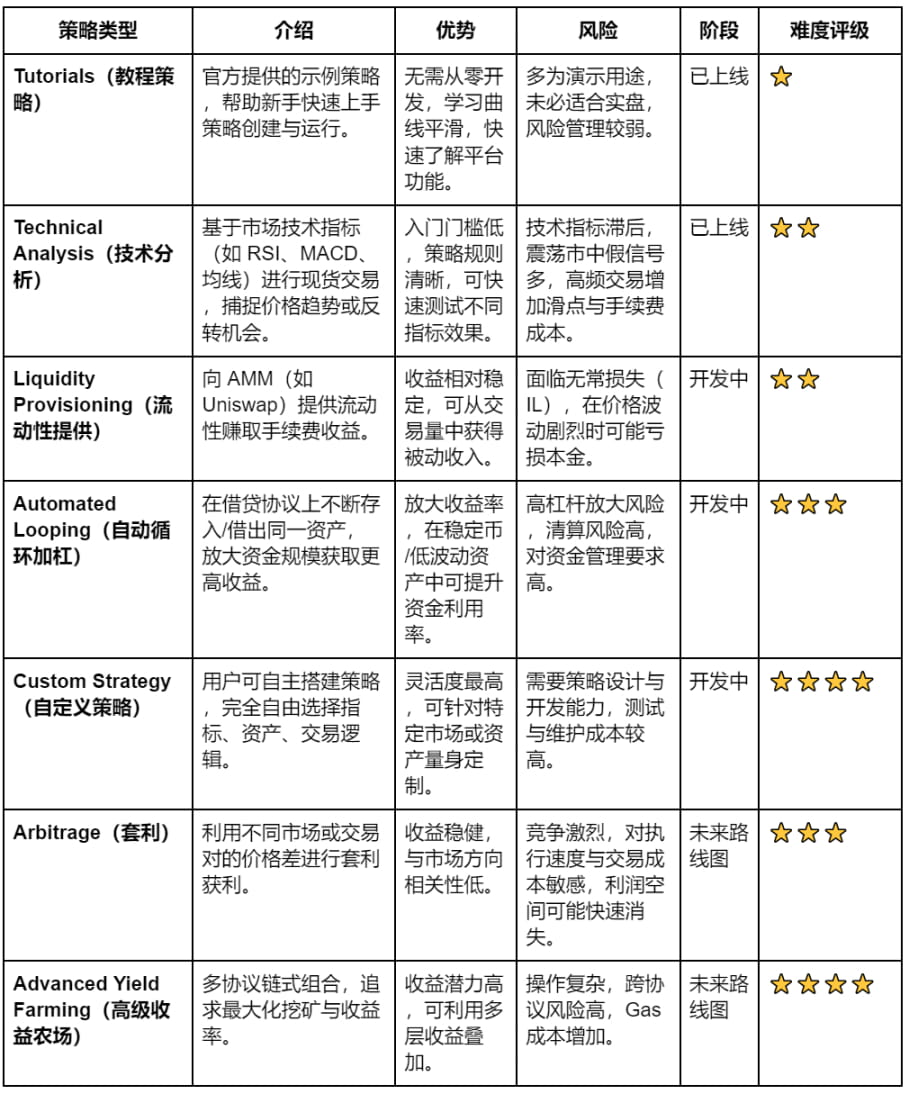

2. Deployment System
Deployments are the core execution layer connecting strategy logic and on-chain execution, responsible for automatically completing transactions and operations within the user's authorized permission scope. The current main form is StrategyDeployment, which runs periodically or triggered according to preset logic, suitable for executing clearly defined, reproducible trading strategies, emphasizing stability and controllability. The upcoming LLMDeployment will introduce one or more large language models (LLM) as decision engines, enabling strategies to adapt to market changes and continuously learn and optimize within a strictly controlled permission framework to explore new trading opportunities.
The Deployment workflow covers the entire process from authentication authorization, strategy execution, transaction construction, permission verification, to signature submission and execution monitoring. The underlying execution is completed by core classes maintained by the official: TransactionManager converts strategy actions into compliant on-chain transactions and simulates verification; AccountManager generates transaction signatures; ExecutionManager broadcasts transactions, tracks status, and retries when necessary, forming a highly reliable closed loop from strategy to on-chain execution. In the future, Almanak will expand to multi-Deployment collaboration, cross-chain execution, and enhanced analytical capabilities to support more complex multi-agent strategy operations.
3. Wallet System and Security Mechanism
The wallet system is the core of ensuring fund security and controllable strategy execution. Almanak adopts a non-custodial solution of Safe + Zodiac, ensuring users have complete ownership of their funds, and precisely and controllably delegating the necessary permissions for strategy execution to automated execution accounts (Deployment EOA). Users directly control the Safe Wallet through User Wallet (EOA or ERC-4337 smart account). The Safe Wallet embeds the Zodiac Roles Modifier module, allowing strict function whitelisting and parameter restrictions to be set for Deployment EOA, ensuring 'only allowed actions can be performed', and permissions can be revoked at any time.
Deployment EOA is hosted by the platform, with its private key using enterprise-level encrypted static storage, and is hosted by Google security infrastructure, with no access by anyone throughout the entire process. In extreme cases, the platform will immediately notify users to revoke permissions and generate a new EOA for replacement, ensuring uninterrupted strategy operation. To ensure continuous execution of strategies, users need to purchase Autonomous Execution Fees service packages to cover on-chain running costs (including Gas). This architecture achieves institutional-level security standards through the complete isolation of funds and execution permissions, refined permission management, institutional-level key security, and rapid abnormal response, laying a trust foundation for the large-scale popularization of automated DeFi strategies.

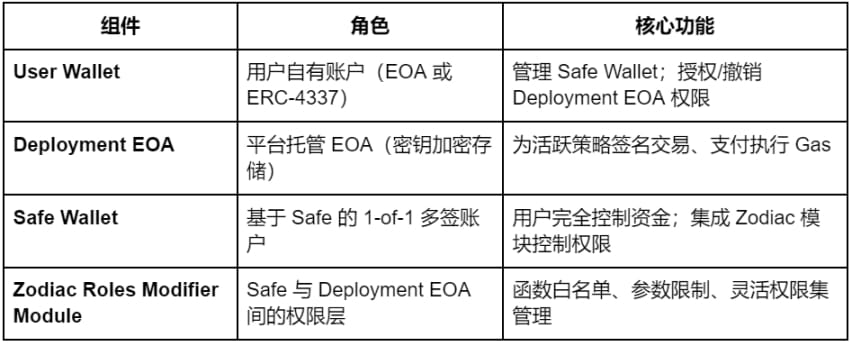
4. On-chain Quantitative Strategy Vaults
Almanak Vaults are user-deployable, fully on-chain, permissionless vault contracts that convert trading strategies into tokenized, composable financial products. Unlike static 'closed containers', these vaults are built based on the asynchronous expansion standard ERC-4626 ERC-7540 and are designed as programmable capital allocators that can natively integrate into the DeFi ecosystem.
By tokenizing AI-generated strategies, Vaults introduce a new DeFi primitive: the strategy itself becomes an ERC-20 asset, which can be used for LP, collateral, trading, transfer, or combined into structured products. This composability unlocks 'DeFi Legos' at the strategy level, enabling seamless integration with protocols, funds, and structured products.
Vaults can be owned by individual curators or communities. Almanak Vaults are implemented based on Lagoon Finance's open-source contract (MIT license), inheriting Lagoon's auditing and security guarantees and complying with ERC-7540 standards. Its permission management mechanism is consistent with Almanak Wallets, relying on Zodiac Roles Modifier to execute function whitelisting and parameter restrictions, ensuring that all operations are strictly completed within the authorized scope.
The operation process includes:
Strategy binding – Binding existing Python strategies or AI-generated strategies to Vaults;
Capital raising – Investors purchase vault tokens to gain proportional ownership;
On-chain execution and rebalancing – Vaults execute trades and dynamically adjust positions based on strategy logic;
Profit distribution – Distributes earnings based on token ownership ratio, with management fees and performance fees automatically deducted.
Core Advantages:
Each vault position exists in the form of ERC-20 tokens, ensuring portability and interoperability;
Strategies are deterministic, auditable, and executed on-chain;
Capital is both safe and liquid—security and composability are no longer opposing forces;
Developers can integrate vault tokens into their protocols without permission, while capital allocators can flexibly allocate capital within the ecosystem.
In short, Almanak Vaults evolve DeFi capital management from isolated packaging containers to intelligent, composable systems. By tokenizing AI-generated strategies, it pushes DeFi beyond passive yield containers, moving towards responsive, modular capital networks, realizing a long-held vision of programmable, interoperable finance.
5. DeFi Agentic Swarm
The Almanak AI Swarm architecture, as a one-stop platform covering the entire strategy development cycle, allows users to autonomously conduct research, testing, creation, and deployment of complex DeFi strategies while maintaining complete control and non-custodial assets. It aims to simulate and replace the entire workflow of traditional quantitative trading teams. Notably, the AI Swarm 'team' consists entirely of AI agents rather than real people.
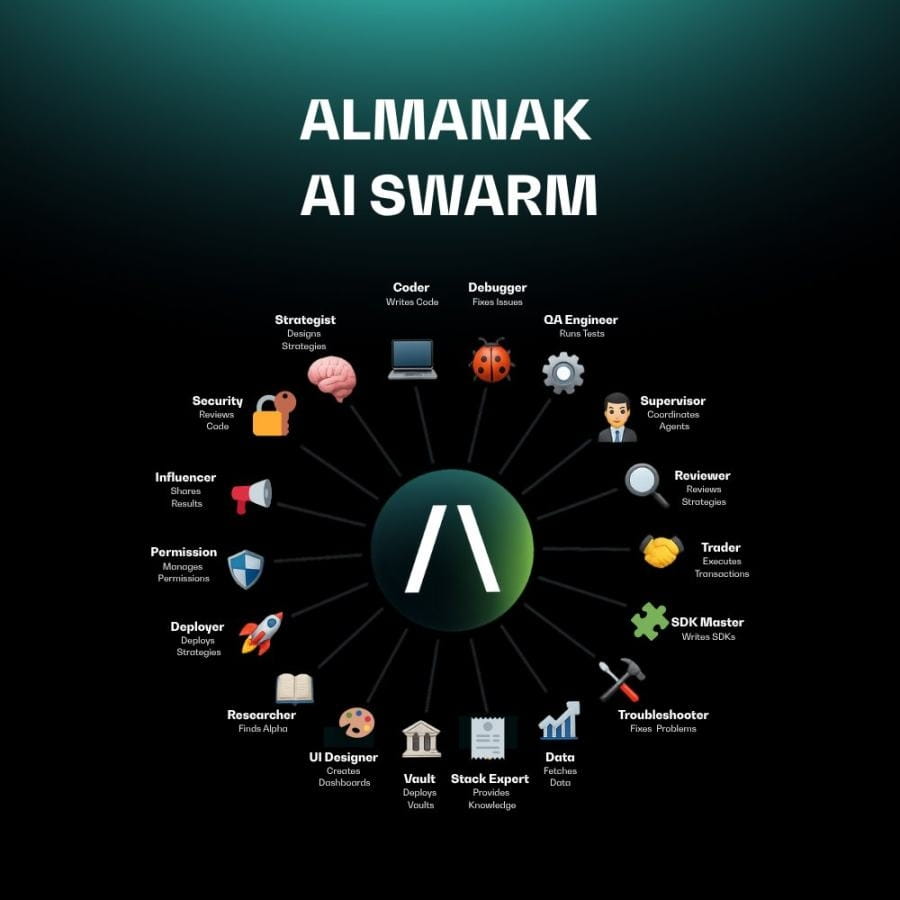
Strategy Team: Transforms users' natural language instructions into deployable on-chain strategies, covering strategists (designing logic), programmers (writing smart contract code), auditors (verifying correctness), debuggers (fixing errors), quality engineers (running simulation tests), permission administrators (configuring execution permissions), UI designers (building visualization panels), and deployers (executing mainnet deployments), ensuring a complete link from conception to execution.
The strategy team implements deterministic process orchestration, persistent state sharing (TeamState), human-machine dual verification (HITL), parallel processing, and interruption recovery mechanisms through LangGraph. The entire process can be executed automatically but defaults to requiring human confirmation to ensure reliability.
Alpha Seeking Team: Continuously scans the entire DeFi market, identifies inefficiencies, explores new ideas and Alpha opportunities, and proposes new logic and strategy ideas to the strategy team.
Optimization Team: Rigorously evaluates strategy performance through large-scale simulations of historical and predictive market data, conducting hypothetical stress tests and periodic performance analysis before deployment to identify potential drawdowns and weaknesses, ensuring strategy stability and robustness across different market environments.
Additionally, auxiliary AI tools include Stack Expert AI and Troubleshooting AI: the former focuses on answering various user questions about Almanak's tech stack and platform operations, providing instant technical support; the latter focuses on real-time monitoring and problem identification during strategy execution to ensure stability and continuity of strategy execution.
Almanak's core principle is that all AI operations will be recorded, reviewed, and structured, no AI will operate independently, and all strategy logic must undergo complete human-machine dual verification before going live, with users having final control and custody.
Four, Almanak's Product Progress and Development Roadmap
Autonomous Liquidity USD Vault
Currently, Almanak has officially launched the Autonomous Liquidity USD (alUSDC Vault) stablecoin yield optimization vault deployed on the Ethereum mainnet through the community. Like other lending yield AgentFi products such as Giza and Axal, its core is the Stable Rotator Agent, which continuously scans the DeFi ecosystem, identifies and captures the highest available yield opportunities, and automatically rebalances the portfolio based on customizable risk parameters. Strategies will undergo smart trading cost analysis before execution, only adjusting positions when the yield increase is sufficient to cover all costs, and combining advanced routing optimization and automatic compounding features to maximize fund efficiency. Currently, the underlying vault connects to various USDC derivative assets from protocols such as Aave v3, Compound v3, Fluid, Euler v2, Morpho Blue, and Yearn v3.
Almanak's liquidity strategies and Swap trading strategies
The strategies that Almanak has launched can be divided into two main categories: LP series (Dynamic LP Blue Chip, Dynamic LP Degen) and indicator spot strategies (MyAmazingStrat, PENDLERSI_Momentum, VIRTUALBollingerBandsMeanReversion), with detailed strategy content as follows:
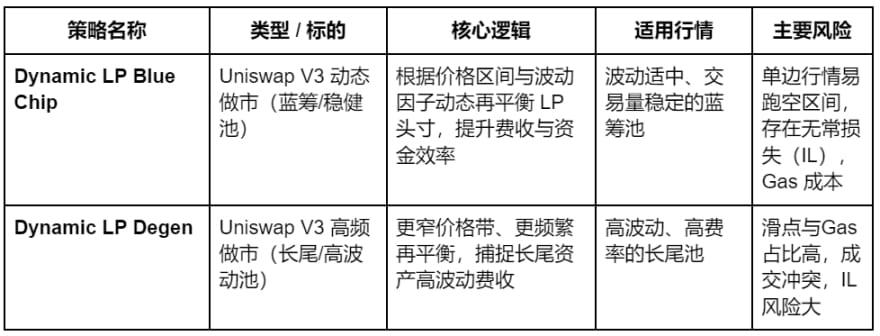
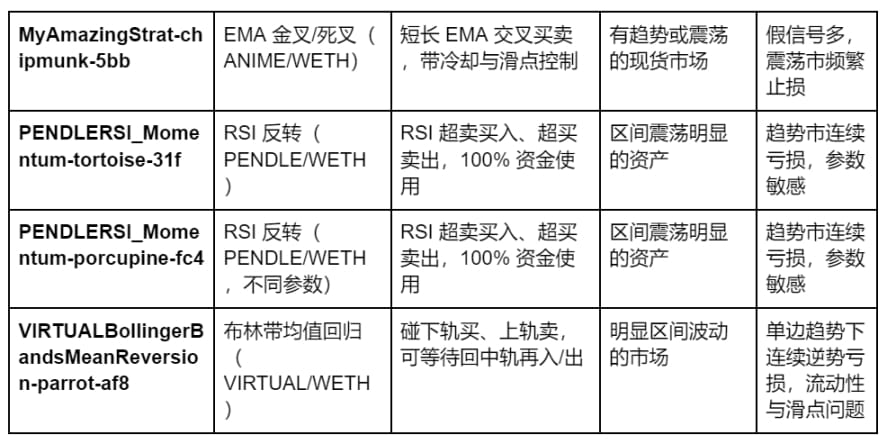
Through AI tools analyzing the above strategy codes, we can draw the following conclusions:
LP dynamic market-making (Blue Chip / Degen) is suitable for pools with continuous trading volume and can accept impermanent loss; Blue Chip seeks stable fee income, while Degen seeks higher-frequency yield capture.
Indicator spot (EMA/RSI/BB) enables light, long-target multi-parameter grid experiments; but strict control over cooling/slippage/minimum transaction volume must be enforced, while paying attention to pool depth and MEV.
Funds and scale: Long-tail assets (Degen/ANIME/VIRTUAL) are more suitable for small/batch strategies to diversify risk control; blue-chip LPs are more suitable for mid-to-long-term/higher TVL.
Minimum viable real trading combination: Dynamic LP Blue Chip (stable fee income) + RSI/BB-type spot strategy (volatility capture) + small amount deployment Degen LP or EMA crossover for 'high volatility test field'.
Almanak Development Roadmap
Almanak's platform evolution is divided into three phases, gradually achieving expansion from the technical base to full-chain accessibility.
Phase 1 focuses on infrastructure and early community building, launching a public beta version that covers a complete quantitative trading stack, and forming a core user group through the Legion platform to distribute private testing qualifications. Meanwhile, funds will begin to enter the community vault strategy designed by AI, achieving the on-chain automated management of the first batch of assets.
Phase 2 Almanak plans to fully open the AI Swarm feature to the public by the end of this year. Before that, access will gradually be relaxed as the system expands for large-scale usage, marking the formal implementation period of the platform token economy and incentive system.
Phase 3 will shift focus to attracting global retail users, launching user-friendly products aimed at savings and retirement accounts, and integrating with centralized exchanges (such as Binance, Bybit) to achieve seamless connection between CeFi and DeFi. At the same time, it will expand asset classes using low-risk, high-capacity RWA strategies and launch a mobile application to further lower user participation thresholds.
In addition, Almanak will continue to expand multi-chain support (including Solana, Hyperliquid, Avalanche, Optimism, etc.), integrate more DeFi protocols, and introduce multi-agent collaboration systems (Multi-Agent System) and Trusted Execution Environments (TEE), through AI-driven automatic discovery of Alpha, constructing the world's most comprehensive AI DeFi intelligent execution network.
Five, Almanak's Token Economics and Points Incentive
Almanak's token economic system aims to build an efficient and sustainable value exchange network for AI-driven financial strategies, enabling high-quality strategies and liquid capital to achieve efficient matching on-chain. The platform constructs an ecosystem closed loop through dual-core role strategies and vault curators (Strategy & Vault Curators) and liquidity providers (Liquidity Providers): the former uses an AI agent cluster (Agentic AI-Swarm) to design, optimize, and manage verifiable deterministic strategies in a no-code environment, introducing external funds through deploying permissionless vaults (Vault) and collecting management fees and performance sharing; the latter deposits funds into these Vaults to gain exposure to tokenized strategies and participate in profit distribution.
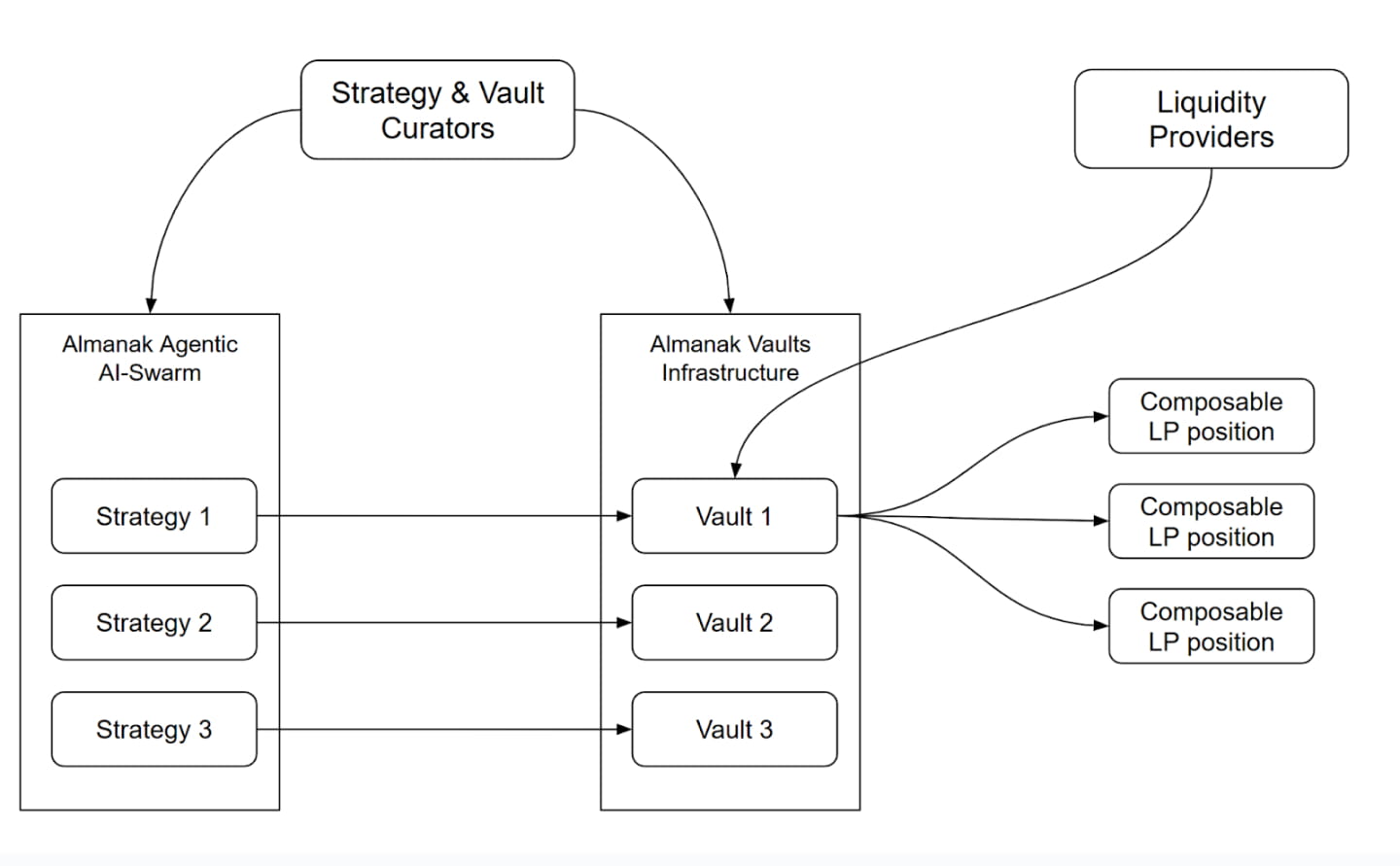
In terms of strategy privacy, strategy curators can choose a private mode (closed source, not included in the strategy library, accessible only by themselves) or a public mode (open source and included in the strategy library for community and third-party protocol use), thus achieving a balance between IP protection and knowledge sharing.
The token economic model draws on the dynamic capital allocation logic of traditional hedge funds, integrating Bittensor's demand-driven emission distribution mechanism with Curve Finance's governance incentive model: the former allocates emissions weighted by TVL and strategy yield, encouraging capital to concentrate on high-performance strategies; the latter introduces the 'veToken + Bribe' model, allowing protocol parties to vote to increase the emission multiplier of specific Vaults, thereby guiding the flow of AI agents (agentic traffic) toward designated protocols.
Emission distribution adopts a weighted formula based on AUM and ROI, ensuring that Vaults' contributions to attracting capital and generating returns are directly converted into token rewards; the governance bonus mechanism (Almanak Wars) can stack a maximum of 3x weight for target Vaults, forming an incentive market among project parties, curators, and liquidity providers. To maintain long-term sustainability, protocol fees (Vault fee shares, computation resource surcharges, etc.) will be partially returned to the emission pool, gradually offsetting new emission pressure as the ecosystem matures.
Token functions include Staking and Governance: Token holders can stake to obtain discounts on platform computational resources, increase voting power, direct emissions to specific Vaults, and participate in DAO governance to decide key parameters such as computation resource markup, Vault fee percentages, emission curves, etc.


In token distribution, Almanak sets the following: team (54 months linear release, 12 months lock-up), institutional investors (48 months linear release, 12 months lock-up), advisors (48 months linear release, 12 months lock-up), innovation and ecosystem development (TGE release 35%, remaining 36 months linear release), community and early participants (TGE release 45%), Legion community round (two rounds, first round 30% TGE + 24 months linear release, second round 100% TGE). The emission pool is used to reward network participants and early incentives, allocated according to an annual halving inflation model, maintaining long-term incentives and governance activity.
Almanak Points: A quantitative incentive mechanism for platform participation
Almanak Points are the core mechanism for measuring and rewarding user participation and contribution in the platform, aimed at driving asset accumulation, strategy usage, and community growth through the points system. Points are issued in phases according to seasons, with the emission volume, activities available for participation, and calculation methods adjusted for each season.
Users can obtain Points through various methods: ① Deposit funds into community vaults listed on the Almanak platform, with points calculated based on deposit scale and holding time (current Vault deposits enjoy 2x points multiplier); ② Hold assets in Almanak Wallet, accumulating points based on balance and holding duration; ③ Activate and actively manage Deployments, earning additional points based on asset scale, duration, and strategy complexity; ④ Recommend new users to participate in platform activities, earning an additional 20% of the recommended user's points as a reward. Points are non-transferable and non-tradable but will convert to tokens at a 1:1 ratio during token issuance. Meanwhile, points will also serve as a basis for governance rights, functional usage permissions, and ecosystem benefits.
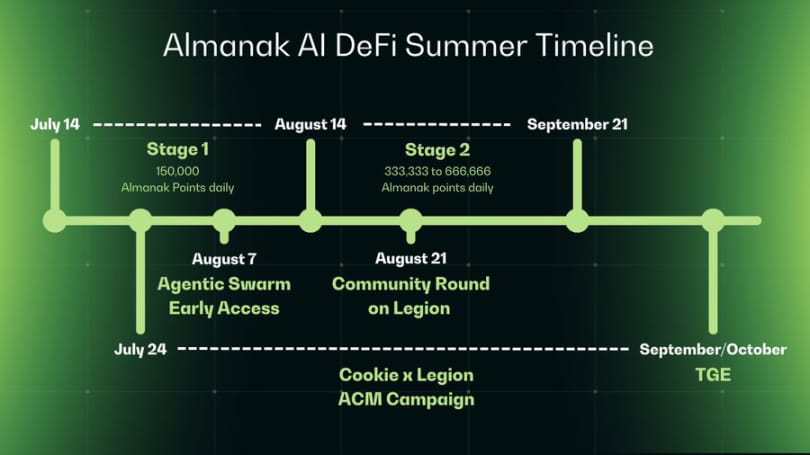
Project Financing and Token Issuance Strategy
Almanak collaborates deeply with Cookie.fun and Legion.cc, introducing the Snaps/cSnaps mechanism to analyze on-chain traceable contribution points through Attention Capital Formation mode, linking user activity in community dissemination, content interaction, and financial support across multiple dimensions directly to token distribution, achieving a transparent and structured distribution logic of 'contribution equals ownership'.
In terms of capital background, Almanak received incubation support from Delphi Digital and the NEAR Foundation in its early stages, and subsequently attracted investments from well-known institutions such as Hashkey Capital, Bankless Ventures, Matrix Partners, RockawayX, AppWorks, Artemis Capital, and SParkle Ventures, with a total financing amount of $8.45M.
January 8, 2025: Completed $1M IDO through Legion, with a valuation of $43M, TGE unlocks 30%, the remaining 70% set for a 6-month lock-up period, and linear release over 24 months.
August 21, 2025: Upcoming Legion community round financing, with a valuation of $90 million FDV, aiming to raise $2 million, with a maximum cap of $2.5 million. This round is open to all verified accounts, and tokens will be 100% fully unlocked at TGE. TGE is expected to occur from late September to early October.
Cookie DAO priority rights: The top 25 Snappers and the top 50 cSnappers can enjoy priority rights for investment of $75 million FDV, and will also unlock 100% at TGE.
Event incentives – 0.55% of the total supply will be used for incentive distribution: of which 0.4% is allocated to the top 500 cSnappers (accounting for 80% of the reward pool), 0.1% is allocated to the top 250 Snappers, and 0.05% is allocated to $COOKIE stakers.
This issuance mechanism not only optimizes the fairness and participation threshold of token distribution but also deeply binds capital raising, community building, and long-term governance, forming a sustainable community of shared interests, laying the foundation for Almanak's long-term expansion in the AI × DeFi track.
Six, Investment Logic and Potential Risk Analysis
Investment Logic
Almanak currently aligns more with the positioning of 'the easiest retail DeFi strategy sandbox', with significant advantages in user experience, security architecture, and low barriers to entry, especially suitable for retail investors with no coding experience or lack of on-chain strategy experience to quickly start. Almanak's core competitiveness lies in the deep integration of AI multi-agent architecture and non-custodial execution system, providing institutional-level security and strategy privacy protection while ensuring performance. Its tech stack consists of TEE (Trusted Execution Environment) + Safe Wallet + Zodiac Roles Modifier, allowing fully automated on-chain execution under permission management with granular precision down to contract function parameters, significantly superior to most AgentFi models that rely solely on EOA delegation.
The technical architecture has formed a complete closed loop: from data acquisition (Sensors), strategy logic execution (persistent state machine architecture, Prepare / Validate / Sadflow), transaction execution (TransactionManager / AccountManager / ExecutionManager), to monitoring and metrics systems, and then productization (ERC-7540 Vault) and external fundraising fees, the link is smooth and has commercial scalability. Particularly, the productization capability of Vault makes strategies upgrade from self-use tools to marketable financial products, bringing the platform scalable management fees and performance-sharing income.
On the operational side, the Points incentive system has been launched, with rules transparent and AUAM (Assets under Agentic Management) oriented, effectively driving lock-up amounts and activity; through Attention Capital Formation mode analyzing on-chain traceable contribution points, deeply binding capital raising, community building, and long-term governance, forming a sustainable community of shared interests, laying the foundation for Almanak's long-term expansion in the AgentFi track.
Potential Risks
Although Almanak has achieved a high level of completeness in its technical and functional systems, it still faces several key challenges:
Firstly, protocol testing has not yet been fully opened. Currently, it only supports lending protocols on the Ethereum mainnet, as well as LP and Swap strategies based on Uniswap V3. The underlying Kitchen already supports Ethereum, Base, and Arbitrum, and has the capability to expand to 8+ EVM chains and 200+ protocols. The broader opening rhythm of multi-chain expansion (such as Base, Solana, Hyperliquid), multi-protocol access, and CEX integration will directly affect strategy diversity, profit opportunities, and market competitiveness.
Secondly, the strategy level is still relatively basic. Existing strategies are mainly based on entry-level technical analysis (TA), and there is still a gap from institutional or professional quantitative standards. In the future, it is necessary to introduce a richer library of advanced strategies (covering on-chain liquidity management, funding rate arbitrage, cross-pool pricing, and multi-signal fusion, etc.), and improve backtesting and simulation trading tools, built-in cost optimization engines, and multi-strategy portfolio management features in order to become the preferred entry point for retail investors into DeFi quantification.
Furthermore, the ecosystem and user base are still in the early stages. Although the points program and Vault mechanism have been launched and entered the first tier of AgentFi, the growth of TVL managed by AI-driven Vaults still requires time for validation, and user activity and retention will be key indicators in the medium to long term.
Overall, Almanak possesses a combination of mature technical architecture, clear commercialization paths, and driving incentive mechanisms, making it rare in the AI-driven on-chain quantitative and asset management track. However, the speed of ecosystem expansion, evolution of competitive landscape, and stability of technological implementation will be the three core variables determining its ability to maintain a long-term lead.

